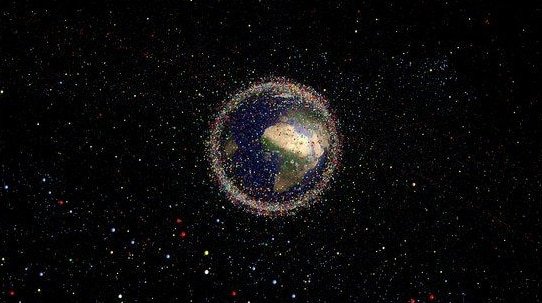
Health Editor’s Note: We drive along highways and see plastic bags, wounded tires, car bumpers left over from accidents, paper, metal and the thought goes through your head, “why does someone not pick that up?” There are portions of highways and roads that are assigned to organizations or groups who volunteer to pick up the trash and get rid of the pollution. There are signs that tell you that these groups are monitoring for debris.
I can remember when it was not uncommon to see someone throw something out of the car window. We developed a name for this discarded waste, litter. We began to make littering illegal but then of course, no one can be watching all the time. How does one clean up pollution and debris that is out in space? Why was it allowed to be there in the first place? When you think of the enormous cost of the things that are sent into space, you would think that someone would want to reclaim/recycle such items. If it can be put up there it should be able to be taken down, safely, so we are not hit by it when it can no longer be held in orbit….Carol
Space Junk Menace: New Guidelines Urged to Help Fight Orbital Debris Threat
by Mike Wall/Space.com
The final frontier may need a little taming.
About 2,000 operational satellites currently zoom around Earth, studying our planet’s weather, beaming down telecommunications data and performing a variety of other tasks. But that number has been rising steadily as the costs of building and launching spacecraft fall, and it’s about to make some big leaps.
For example, SpaceX, Amazon and OneWeb all plan to set up internet-satellite megaconstellations in the near future. This past May, SpaceX launched to low-Earth orbit the first 60 members of its Starlink network, which could eventually feature up to 12,000 satellites.
But not all of the coming Earth-circling spacecraft will be operated by aerospace professionals working for deep-pocketed companies or government agencies. A fair number will be run by neophytes who just a few short years ago couldn’t have dreamed of being part of the space scene.
Indeed, that’s already happening, because “even, frankly, elementary schools can afford to put up these little experimental satellites,” Walter Scott, chief technology officer of Maxar Technologies, told Space.com.

Carol graduated from Riverside White Cross School of Nursing in Columbus, Ohio and received her diploma as a registered nurse. She attended Bowling Green State University where she received a Bachelor of Arts Degree in History and Literature. She attended the University of Toledo, College of Nursing, and received a Master’s of Nursing Science Degree as an Educator.
She has traveled extensively, is a photographer, and writes on medical issues. Carol has three children RJ, Katherine, and Stephen – one daughter-in-law; Katie – two granddaughters; Isabella Marianna and Zoe Olivia – and one grandson, Alexander Paul. She also shares her life with her husband Gordon Duff, many cats, and two rescues.
ATTENTION READERS
We See The World From All Sides and Want YOU To Be Fully InformedIn fact, intentional disinformation is a disgraceful scourge in media today. So to assuage any possible errant incorrect information posted herein, we strongly encourage you to seek corroboration from other non-VT sources before forming an educated opinion.
About VT - Policies & Disclosures - Comment Policy




It’s a big sky out there and an even bigger space.
WHY? Do you ask? For the same reason oil companies have flared off excess natural gas for over half a century (if not longer) instead of capturing, and selling it. It is cheaper. The same thinking applies to the space program. They have always done things on the cheap. Even when spending millions. Look what happened to Challenger. If they think so little of killing astronauts, do you really think they actually care about space debris?
Comments are closed.